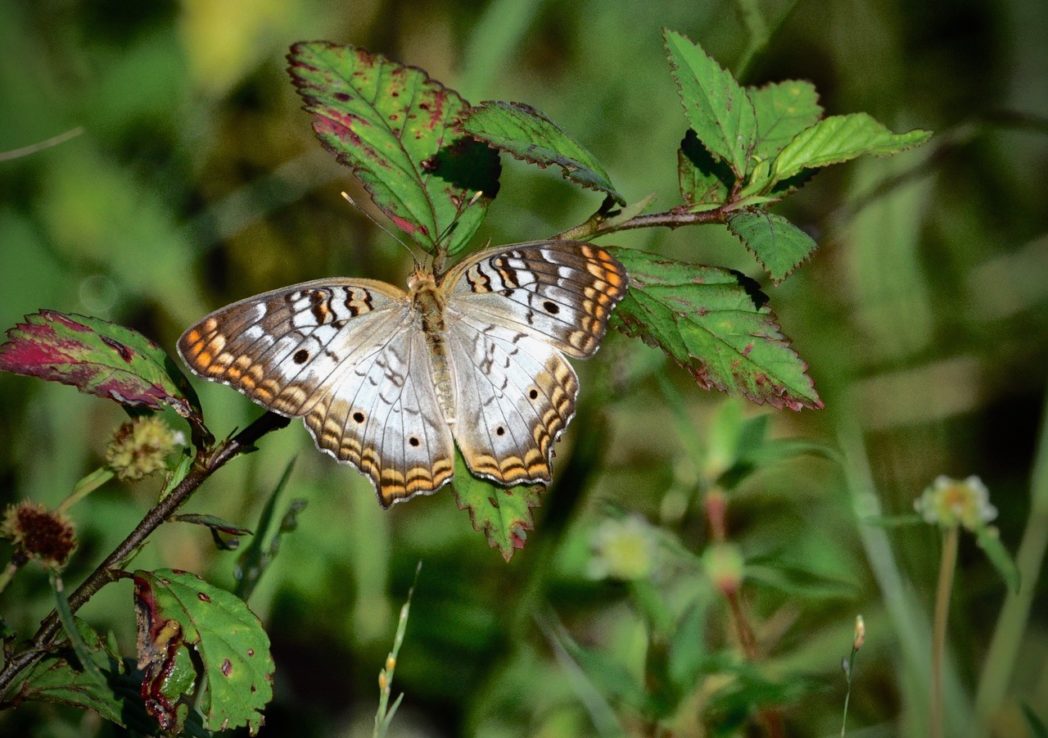White peacock
“Know your native pollinators” is a series of articles that will help you identify and appreciate Florida’s varied pollinators, including bees, wasps, butterflies, moths, beetles, flies, birds and bats. Pictured above: White peacock (Anartia jatrophae) by Steve Van Meter.
Have you ever seen a White peacock? No, not the bird. There’s a good chance you have seen a White peacock butterfly! They are commonly seen flying low to the ground in Florida throughout the year.
CLASSIFICATION
Class: Insecta
Order: Lepidoptera
Family: Nymphalidae
Subfamily: Nymphalinae
Genus species: Anartia jatrophae
FORAGING PREFERENCES
Host plants of the White peacock butterfly include Herb-of-grace (Bacopa monnieri), Wild petunia (Ruellia caroliniensis), Southern frogfruit (Lippia stoechadifolia), Carolina false vervain (Verbena carnea) and Turkey-tangle frogfruit (Phyla nodiflora), which is also a favorite nectar flower. Another is the ubiquitous Beggarticks (Bidens alba), as well as other flowers in the Asteraceae family.
IDENTIFICATION
White peacocks are part of the family of brush-footed butterflies. Small to medium in size, their wingspans range from 3.5 to 6 cm. They are white with brown markings and orange margins, and have a small black spot in the center of each of the forewings. Two small black spots on each of the hindwings resembling a peacock’s eyespot give this butterfly its common name. There is a short tail on the hindwings. Male and female White peacock butterflies do not differ in appearance from each other.
White peacocks are smaller and darker during wet summer months and larger and paler in the drier winter months.
HABITAT
In addition to Florida, the White peacock can be found throughout the southeastern United States, the Caribbean, Mexico and South America to Argentina. Occasionally in warmer months, White peacocks will wander north to Wisconsin or New Jersey. They especially like warm weather and thrive in South Florida. Look for these butterflies in disturbed areas, ditches, canals, pond edges, marshes, lakes, roadsides and anywhere with weedy low-lying plants.
LIFE CYCLE
Eggs are green and laid singly on the host plant or nearby on the ground. Eggs will hatch within 3 to 10 days of being laid. The mature larva is black with small white spots and black spines. The chrysalis is green and can stay in this stage up to 14 days. White peacocks are a common sight in Florida and, with multiple generations, they can be seen all year long. Their life span is about four months.
References:
- Butterflies at Home. “White Peacock Butterfly.” 2020.
- Florida Museum. “White peacock, Anartia jatrophae.” University of Florida. Aug 24, 2020.
- Lotts, Kelly and Thomas Naberhaus, coordinators. 2017. Butterflies and Moths of North America. 2020.
- Sedore, David. “White peacock butterfly, Anartia jatrophae.” Wild South Florida. 2015.

